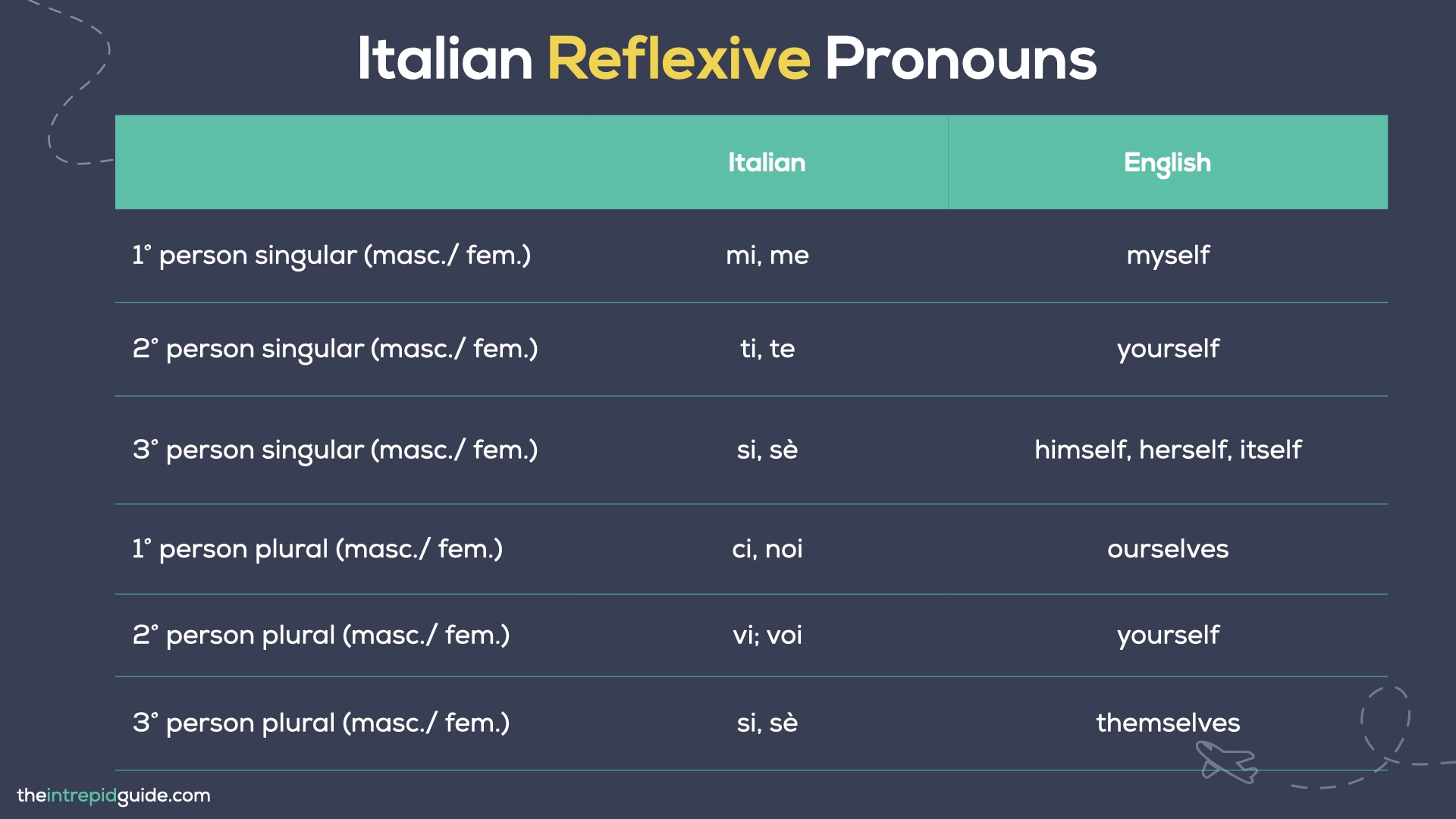Italian reflexive pronouns are special words used when the subject of a sentence is also the object of the action. Think of them as mirrors reflecting the action back onto the doer!
Confused? Let’s clarify with an example:
- Tutte le sere, Giovanna pettina Greta prima di andare a dormire.( Every evening, Giovanna combs Greta’s hair before going to bed.)
Here, Giovanna is the subject (doing the combing) and Greta is the object (having her hair combed).
Now, if Giovanna combs her own hair, the sentence transforms into:
- Tutte le sere, Giovanna si pettina prima di andare a dormire(Every evening, Giovanna combs her own hair before going to bed).
Si is the reflexive pronoun here, showing that Giovanna is both the subject and the object of the combing action.
In the world of Italian pronouns, reflexive pronouns are part of the larger personal pronouns group. This group also includes subject pronouns (like io, tu), direct object pronouns (like lo, la), and indirect object pronouns (like mi, gli).
Additionally, reflexive pronouns are often used with reflexive verbs that typically describe personal care or daily routines, such as lavarsi (to wash oneself), vestirsi (to dress oneself), pettinarsi (to comb oneself), etc.
This guide will help you understand how to use reflexive pronouns correctly in various sentences, so your Italian sounds more fluent and authentic. To see how much you’ve learned, don’t forget to complete the free quiz at the end of this lesson to test your new-found knowledge!
Before we get started, make sure you download your FREE PDF cheat-sheet for this lesson which includes a practical summary of everything you’ll learn in this guide. Just enter your email below and I’ll send it to you straight away.
By the way, want to improve your Italian quickly and having fun doing it?
I thought so.
If you’re a beginner, I recommend Intrepid Italian, my comprehensive self-paced programme that teaches you through the power of my unique 80/20 method. The course covers everything you need to know as a beginner in Italian (including how to use pronouns). Join now for lifetime access and my 30-Day “Celebrate with a Spritz” money-back guarantee by clicking here.
Or if you’re already at the intermediate level, why not enrol in Intrepid Italian for Advanced Beginners (A2) or Intrepid Italian for Intermediates (B1), my more advanced programmes that helps you master the trickiest aspects of Italian grammar while as you edge closer to fluency in Italian.
When you start learning Italian, it’s pretty common to keep repeating the same basic phrases and words, but if you’re gunning for fluency, it’s time to shake things up a bit. The key? Familiarize yourself with Italian pronouns to inject rhythm into your sentences!
Cominciamo! (Let’s get started!)
Italian Reflexive Pronouns Chart
| Italian Reflexive Pronouns | |||
|---|---|---|---|
| Italian | English | ||
| Unstressed (Atonic) | Stressed (Tonic) | ||
| 1° person singular (masc./ fem.) | mi | me | myself |
| 2° person singular (masc./ fem.) | ti | te | yourself |
| 3° person singular (masc./ fem.) | si | sè | himself, herself, itself |
| 1° person plural (masc./ fem.) | ci | noi | ourselves |
| 2° person plural (masc./ fem.) | vi | voi | yourself |
| 3° person plural (masc./ fem.) | si | sè | themselves |
How to use Italian Reflexive Pronouns
Here’s a tip: to determine whether a personal pronoun is reflexive or not, simply check if it matches the subject of the sentence. For example:
- Io mi sveglio sempre alle 8.(I always wake up at 8am.)
Here, the pronoun mi is reflexive because it refers back to the subject io (I).
- Lei mi sveglia sempre alle 8. (She always wakes me up at 8am.)
In this case, the pronoun mi is not reflexive because it does not refer back to the subject lei (she).
Unstressed (atonic) reflexive pronouns in Italian
| Unstressed (Atonic) Reflexive Pronouns | ||
| Italian | English | |
| 1° person singular (masc./ fem.) | mi | myself |
| 2° person singular (masc./ fem.) | ti | yourself |
| 3° person singular (masc./ fem.) | si | himself, herself, itself |
| 1° person plural (masc./ fem.) | ci | ourselves |
| 2° person plural (masc./ fem.) | vi | yourself |
| 3° person plural (masc./ fem.) | si | themselves |
What they are: they indicate that the subject of the verb is also its object without carrying the emphasis in the sentence (e.g., io mi lavo – I wash myself).
Placement:
With indicative, subjunctive, and conditional tenses, they typically come before the verb:
- Indicative example: La signora Carla si veste sempre di nero (Mrs. Carla always wear black).
- Subjunctive example: Dubito che lui si ricordi del nostro anniversario (I doubt he remembers our anniversary).
- Conditional example: Mi allenerei ogni giorno se avessi più tempo (I would train every day if I had more time).
With imperative, gerund, participle, and infinitive tenses, they are attached to the end of the verb, creating a single word:
- Imperative example: Vestiti bene per la festa! (Dress well for the party!)
- Gerund example: Vestendosi, ha sentito dolore al braccio? (Did you feel a pain in your arm while dressing yourself?)
- Participle example: Accortomi dell’errore, ho subito cercato di rimediare (Having realized the mistake, I immediately tried to rectify it).
- Infinitive example: Amate vestirvi in modo elegante per le occasioni speciali, vero? (You love to dress elegantly for special occasions, don’t you?)
When a reflexive verb in the infinitive tense is used with a modal verb (potere – can; dovere – must; volere – want), you can use two constructions:
- Placing the reflexive pronoun before the modal verb and the infinitive, e.g., Loro si devono lavare (They must wash themselves).
- Attaching the reflexive pronoun to the infinitive verb that follows the modal verb, e.g., Loro devono lavarsi (They have to wash themselves).
Attenzione!: With compound tenses, the auxiliary essere (to be) is used, and the past participle agrees in gender and number with the subject:
- Francesca si è svegliata (Francesca has woken up).
- Carla e Gianna si sono pettinate (Carla and Gianna have combed their hair).
Stressed (tonic) reflexive pronouns in Italian
| Stressed (Tonic) Reflexive Pronouns | ||
| Italian | English | |
| 1° person singular (masc./ fem.) | me | myself |
| 2° person singular (masc./ fem.) | te | yourself |
| 3° person singular (masc./ fem.) | sè | himself, herself, itself |
| 1° person plural (masc./ fem.) | noi | ourselves |
| 2° person plural (masc./ fem.) | voi | yourself |
| 3° person plural (masc./ fem.) | sè | themselves |
What they are: They add emphasis to the object of the action, highlighting the pronoun itself.
Placement: They always follow the verb. Also, they are often used with the identifying adjective stesso (meaning “self”) in its various forms (stessa, stessi, stesse).
Here are some examples:
- Tu pettina te che ai miei capelli ci penso da sola (You comb yourself; I’ll take care of my hair by myself).
- Per essere felici dobbiamo imparare ad amare noi stessi (To be happy, we must learn to love ourselves).
- Impara ad apprezzare te stessa così come sei (Learn to appreciate yourself as you are).
Attenzione! In the third person, singular and plural, sè followed by stesso, stessa, stessi or stesse is used without an accent.
- I cantanti esprimono se stessi attraverso le loro canzoni (Artists often express themselves through their songs).
- Anna ha trovato la forza di ricostruire se stessa dopo la rottura con Paolo (Anna found the strength to rebuild herself after breaking top with Paolo).
Italian Reflexive Pronouns Quiz
Let’s test your knowledge of Italian reflexive pronouns. Fill in the blanks in these sentences using the correct reflexive pronoun.
If you found this lesson powerful, then you’ll love Intrepid Italian, my series of online self-paced video courses that break down everything you need to know about Italian using my 80/20 method. Visit IntrepidItalian.com for more details.
 Are you a beginner or an intermediate Italian learner? Got a trip coming up or want to communicate with your Italian partner or relatives in Italian? Learn Italian with my unique 80/20 method
Are you a beginner or an intermediate Italian learner? Got a trip coming up or want to communicate with your Italian partner or relatives in Italian? Learn Italian with my unique 80/20 method
Registrations are now open to join Intrepid Italian, my new series of online video courses that use my unique 80/20 method. You’ll go from a shy, confused beginner to a proficient and confident intermediate speaker, with me as your trusty guide.
You’ll finally be able to connect with your Italian partner, speak to your relatives and enjoy authentic travel experiences in Italy that you’ve always dreamed of, and so much more.
As a native English speaker who learned Italian as an adult, I know what it’s like to feel hopeless and lack the confidence to speak. I know what it’s like to start from scratch and to even go back to absolute basics and learn what a verb is!
Intrepid Italian was created with YOU in mind. I use my working knowledge of the English language to help you get into the ‘Italian mindset’ so you can avoid the common pitfalls and errors English speakers make – because I made them once too! I break everything down in such a way that it ‘clicks’ and just makes sense.
No matter what your level is, there is an Intrepid Italian course for you, including:
- 🇮🇹 Intrepid Italian for Beginners (A1)
- 🇮🇹 Intrepid Italian for Advanced Beginners (A2)
- 🇮🇹 Intrepid Italian for Intermediates (B1)
You can join 1, 2, or all 3 courses, it’s entirely up to you. The best part is that you have lifetime access so you learn anytime, anywhere and on any device.
As your guide, I walk you through each lesson, step-by-step, using my unique 80/20 method. My approach is different from traditional methods because I teach you the most important 20% of the language right from the beginning so you can start to speak straight away.
Each course includes video lessons, audio exercises, downloadable worksheets, bonus guides, a private support community, and lifetime access all designed to streamline your learning while having fun.
It even comes with my famous “Celebrate with a Spritz Guarantee”. After 30 days of using Intrepid Italian, if you don’t want to celebrate your new-found Italian skills with an Aperol Spritz, you don’t have to pay a penny! Cheers! 🥂
Join Intrepid Italian here and start learning today!
Ci vediamo lì! (See you there!)
Learning Italian? Check out these Italian language guides
- Italian for Beginners | How to Learn Italian in 3 Simple Steps
- TOP 100 Most Common Italian Words (Plus PDF Cheat-Sheet & Quiz)
- Italian Prepositions:The Only Guide You’ll Ever Need (PLUS Chart)
- 17 Weird Italian Superstitions Italians ACTUALLY Live By
- 17 Must-Know Italian Hand Gestures: The Ultimate Guide
- 10 Ways Natives REALLY Say ‘You’re Welcome’ in Italian
- How to say ‘Please’ in Italian in 9 Ways Like a Native
- 41 Italian Greetings: How to Say ‘Hello’ in Italian Like a Local
- 125 Most Common Italian Phrases for Travel You’ll Ever Need [PLUS Printable]
- 8 DEADLY mistakes in Italian (& How to Avoid Them)
- How to Conjugate Italian Verbs in 3 Simple Steps [Italian for Beginners]
- Is Italian Hard to Learn? 7 Common Mistakes & How to Avoid Them
- Master Days of the Week in Italian (7 Simple Memory Hacks)
- Italian Numbers: How to Count in Italian From 0 to 1 Billion (Plus PDF Download)
- How to Order Food & Drinks in Italian [Italian for Beginners]
- 15 Italian Words You Should NEVER Mispronounce [& How Not To]
- 11 Effective Hacks That’ll Help You Learn Italian So Much Faster
- Top 14 Italian Words You Should NEVER Say [& What to Use Instead]
- 20 Hilarious Everyday Italian Expressions You Should Use
- Romanesco: 25 Cool Roman Dialect Words You Should Use in Rome
- 10 Reasons Why Learning Italian Will Change Your Life
- 10 Italian Expressions Italians Love Saying
- 10 Italian Phrases That Will Instantly Make You Sound more Italian
- Funny Italian Sayings: 26 Food-Related Insults You Won’t Forget
- 15 Romantic Italian Films That’ll Make You Love Italy Even More
- How to Master Common Italian Phrases for Travel (Like a Local!)
Like it? Pin it for later!
Over to you!
Did you enjoy this lesson? Do you have a question? Let me know using the comments section below or join me on social media @intrepidguide or @intrepiditalian to start a conversation.
Thanks for reading and I hope you enjoyed this post.
Like what you see? Subscribe using the form below to have all of my posts delivered directly to your email.




